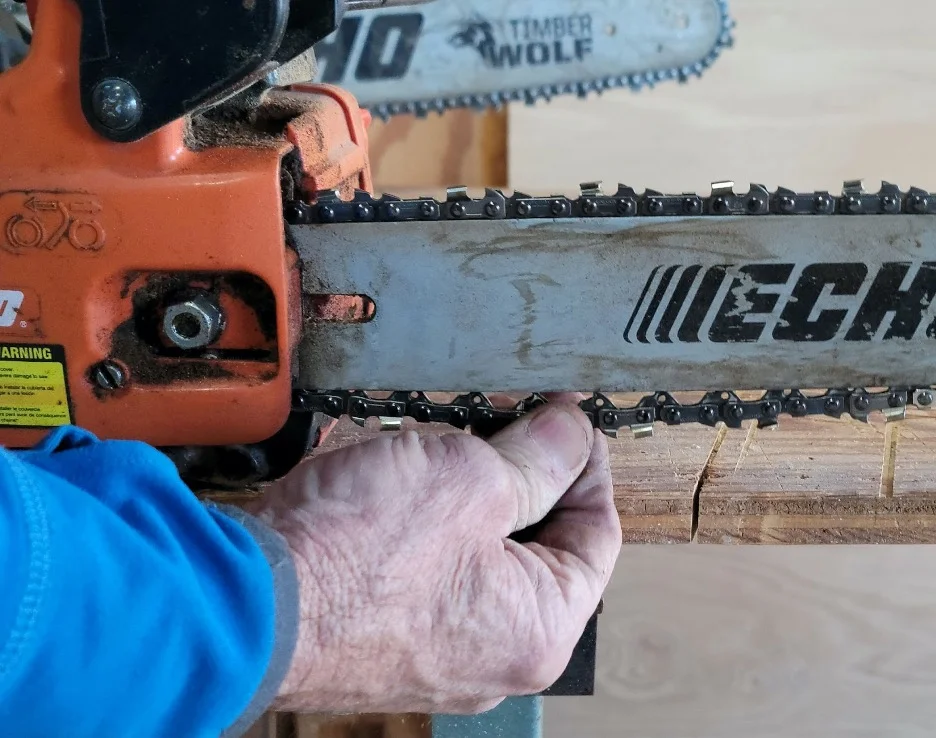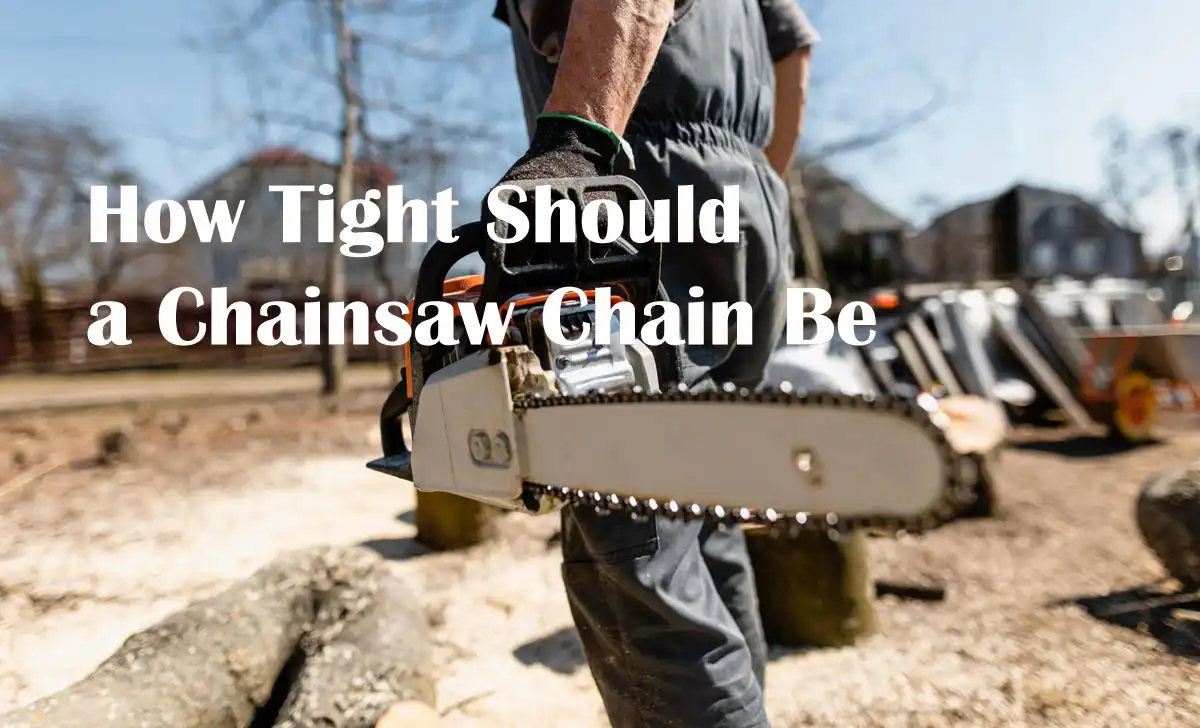A chainsaw chain should be tight enough to not sag below the guide bar but loose enough to allow easy rotation by hand. It should snap back into place when pulled and released.
Ensuring proper chainsaw chain tension is crucial for both safety and effective operation. A well-adjusted chain minimizes the risk of accidents and ensures smooth cuts. As an essential tool for tree felling, pruning, and cutting firewood, your chainsaw demands regular maintenance.
The tension of the chain is a key factor to check before each use. An improperly tightened chain can lead to dangerous kickbacks or reduced cutting efficiency, and may also cause damage to the chainsaw itself. By keeping the chain at the optimal tension, you maximize the lifespan of both the chain and the saw. Thus, regular checks and adjustments are necessary to maintain the performance and safety of your equipment.
About Chainsaw Maintenance
Chainsaw maintenance is key to the safe and efficient use of this powerful tool. Regular upkeep ensures your chainsaw remains in top shape. A crucial aspect of this maintenance involves the chain’s tension, which can significantly impact the chainsaw’s performance.
Understanding the Importance of Chainsaw Chain Tension
Maintaining the right chain tension is critical for optimal chainsaw operation. The correct tension extends the chain’s life, aids in smooth cuts, and provides safer handling. Here’s why:
- Enhanced Safety: A properly tensioned chain reduces the risk of accidents.
- Better Performance: Tight, but not too tight, keeps your chainsaw running efficiently.
- Decreased Wear: Correct tension equals less strain on the chainsaw’s components.
The Risks of Improper Chainsaw Chain Tension
Improper chain tension can lead to various risks, including:
| Too Tight | Just Right | Too Loose |
|---|---|---|
| Causes excess wear | Ensures optimal performance | Increases the chance of derailment |
| Strains the motor | Maximizes safety | Poses a safety hazard |
| Leads to inefficient cutting | Minimizes chain damage | Results in imprecise cuts |
Regular checks and adjustments keep the chain in proper working condition. This ensures the durability and reliability of your chainsaw.
Determining the Ideal Chainsaw Chain Tension
Determining the ideal chainsaw chain tension is crucial for both safety and efficiency. When a chain is too loose or too tight, it can lead to dangerous situations and damage the chainsaw. By achieving the right tension, users ensure the longevity of their tool and a smoother cutting experience.
Manufacturer Guidelines For Chain Tension
Each chainsaw model comes with specific manufacturer recommendations for chain tension. Consulting the user manual before making adjustments is key. Here’s a concise summary of steps to follow:
- Locate the tension specifications in the manual.
- Find the tension adjustment mechanism on your saw.
- Adjust the tension while the chain is at room temperature.
- Ensure the chain rotates freely without sagging or being too tight.
The ‘snap-back’ Test: A Quick Chain Tension Technique
The ‘Snap-Back’ Test is a simple method to check tension:
- Wear gloves for safety.
- Pull the chain slightly away from the bar.
- Release it, allowing it to snap back into place.
If the chain snaps back to its original position without sagging, the tension is good. If it stays loose or is hard to pull, it requires adjustment. Keep in mind to always check the tension when the saw is not in use and the chain is cool.

Adjusting Your Chainsaw Chain: Step By Step
Maintaining the right tension in your chainsaw chain is crucial. A slack chain can easily come off, while an overly tight chain can cause excessive wear. Let’s walk through how to adjust your chainsaw chain tension, ensuring your saw runs safely and efficiently.
Tools Required For Adjusting Chainsaw Chain Tension
Before you start, you’ll need the right tools:
- Chainsaw wrench or a flat-head screwdriver
- Work gloves for safety
Step-by-step Guide to Tightening a Chainsaw Chain
Follow these steps to adjust the chain:
- Power off your chainsaw.
- Wear gloves to protect your hands.
- Check the chain tension by pulling the chain away from the bar.
- If it lifts more than half an inch, it’s too loose.
- Locate the tensioning screw near the chainsaw’s bar.
- Use the wrench or screwdriver to turn the screw clockwise.
- Do this until there’s slight resistance in the chain.
- It should still be able to rotate freely around the bar.
- Lift the tip of the bar and tighten the bar nuts.
Proper tension ensures optimal performance. Test the chain’s tightness again after a few cuts. With practice, adjusting your chainsaw chain becomes a quick and simple task.
Common Mistakes to Avoid When Adjusting Chain Tension
Adjusting the tension of a chainsaw chain is crucial for safe and efficient operation. A poorly adjusted chain can lead to dangerous situations and reduce the lifespan of your equipment. Let’s look at common mistakes to avoid during this process.
Over-tightening the Chain: Potential Consequences
Pulling your chainsaw’s chain too tight is a frequent error. What are the risks?
- Increased wear: Components like the bar and sprocket can wear out faster.
- Overheating: Friction rises, raising the heat level. This can harm your chainsaw.
- Chain snapping: The chain could break. This might hurt you or others.
To find the right tension, lift the chain slightly off the bar. It should snap back into place with a bit of resistance. Remember, the chain should move freely around the bar when you pull it with gloves on.
Neglecting Regular Chain Tension Checks
Regular checks for chain tension are essential. Chains may stretch and become loose during use.
- Before use: Perform a quick tension test as part of your pre-use inspection.
- During use: Chains heat up and expand with use. Pause occasionally to adjust as needed.
- After use: Once your work is done, check the tension again as chains can loosen when they cool down.
Marking your calendar for routine maintenance on your chainsaw helps ensure you never skip this vital step.
Learn more: How to Cut down a Tree With a Chainsaw
Maintenance and Troubleshooting
Keeping your chainsaw in tip-top shape means regular checks. Tension matters for safety and performance. Get it right with these tips.
Routine Chainsaw Maintenance For Optimal Performance
Regular maintenance is key. A well-maintained chainsaw cuts efficiently. It is safer too. Follow these steps:
- Check chain tension before and after use.
- Clean the chain and guide bar often.
- Inspect for worn or damaged parts.
- Keep chain sharp for the best cut.
- Use correct oil to lubricate the chain and bar.
- Ensure air filters are clean for proper engine ventilation.
Troubleshooting Common Chain Tension Issues
Is your chain loose or tight? Here’s what to do:
| Issue | Check | Solution |
|---|---|---|
| Chain too tight | Guide Bar for burrs | File off burrs or replace the bar |
| Chain too loose | Drive Links for damage | Adjust tension or replace the chain |
| Chain won’t stay tight | Tensioning Mechanism for issues | Tighten or replace loose parts |
A tight chain shouldn’t sag. It should move freely by hand. But, it must not be too tight. Too much tension can wear out the chainsaw. A loose chain can jump off the guide bar. That’s dangerous. Always wear protective gear when checking tension.
To know more: Husqvarna 235 Problems
Conclusion
Ensuring the right tension on your chainsaw chain is critical for peak performance and safety. Aim for a snug fit that allows for slight movement. Regular checks and adjustments will prolong your equipment’s life and make cutting tasks more efficient.
Remember, a properly tensioned chain is the secret to smooth operation. For all you chainsaw buffs out there, Chainsaw Hive is the place to be. Pop into our Knowledge corner for a regular dose of all things chainsaw. Trust me, you’ll want to hear what we have lined up next!
